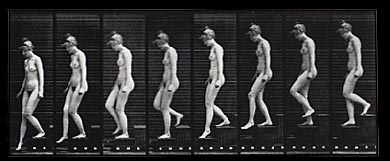

In 1887 Eadweard Muybridge photographed Nude Descending Stairs. His objective was to solve "the problem of locomotion with the aid of photography" (Muybridge, letter to La Nature in 1879). In this study he photographed a model walking downstairs with a series of cameras, evenly distanced in a row, parallel to a backdrop and to the model's course of travel. As the model passed each camera, she tripped the shutter, photographing herself in motion as she walked down the stairs. Because of the multiple camera set up, perspective in each of the eight photos is the same. The effect is that the figure does not appear to walk towards us nor away. There is no shift in perspective we would normally see in a movie or a series of photographs shot from a single vantage point.
The photos collectively do not have a single vantage point for the viewer. Each photo has its own vantage point since each photo was taken by a different camera. Because the cameras were set up on the same axis and in a row, each photo places the vanishing point (and therefore the viewer) in the same spot, in reference to each photograph. When they are seen sequentially, read from right to left, the vanishing point, and as a consequence the viewer, travel along the horizon line. The sequence of photos seem to make visual sense only if we physically move in parallel with the model, photograph by photograph. We feel an almost physical sense of self, moving in space.
Muybridge photographed sequences of action in everyday life that are difficult or impossible to observe. More importantly and perhaps unintentionally, he demonstrated that the viewer could be "moved" through space by pictorial means.